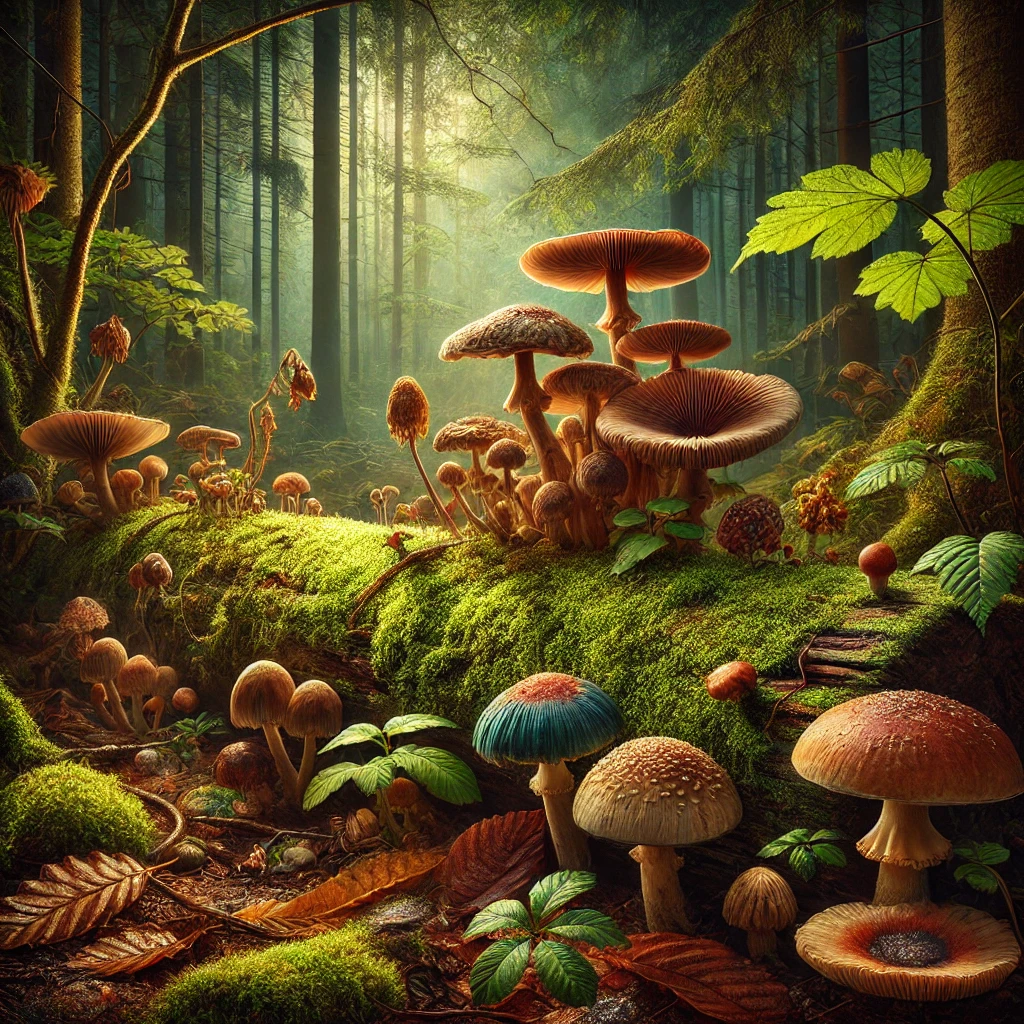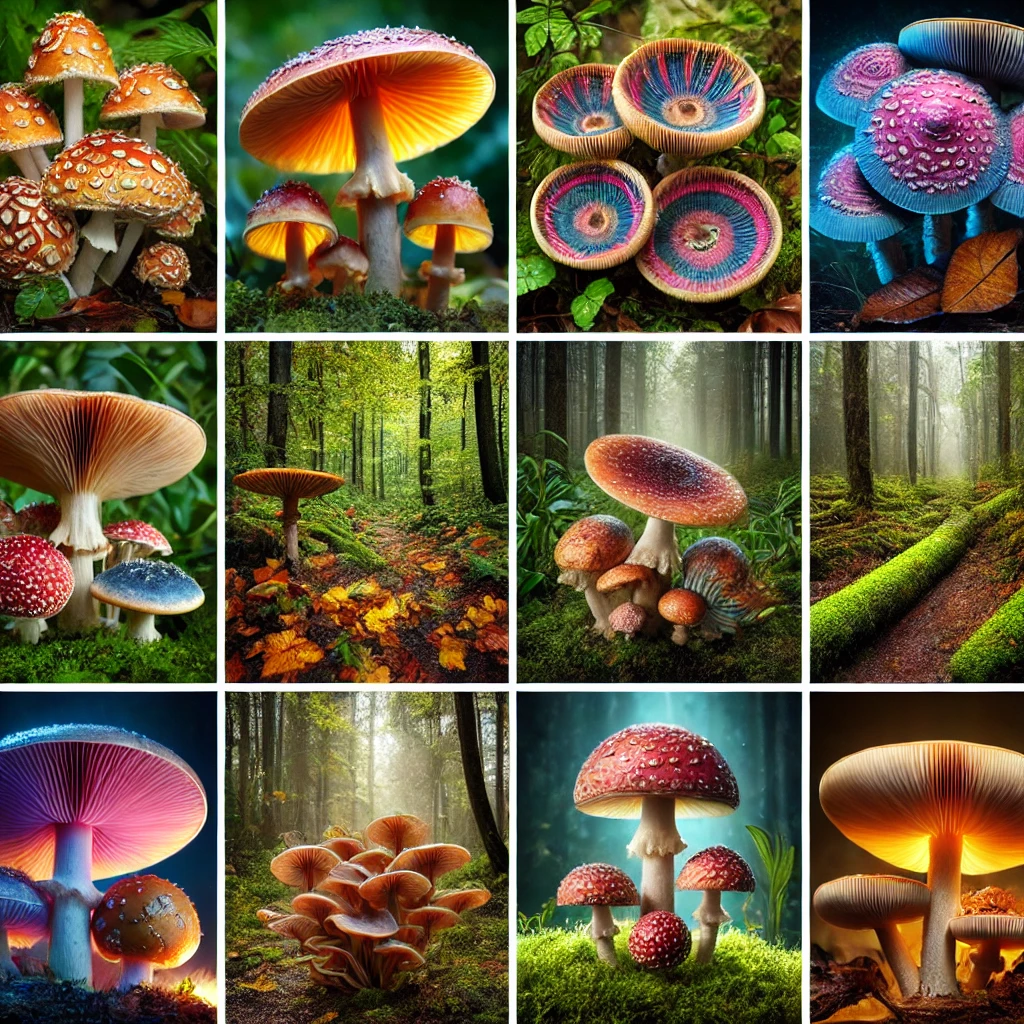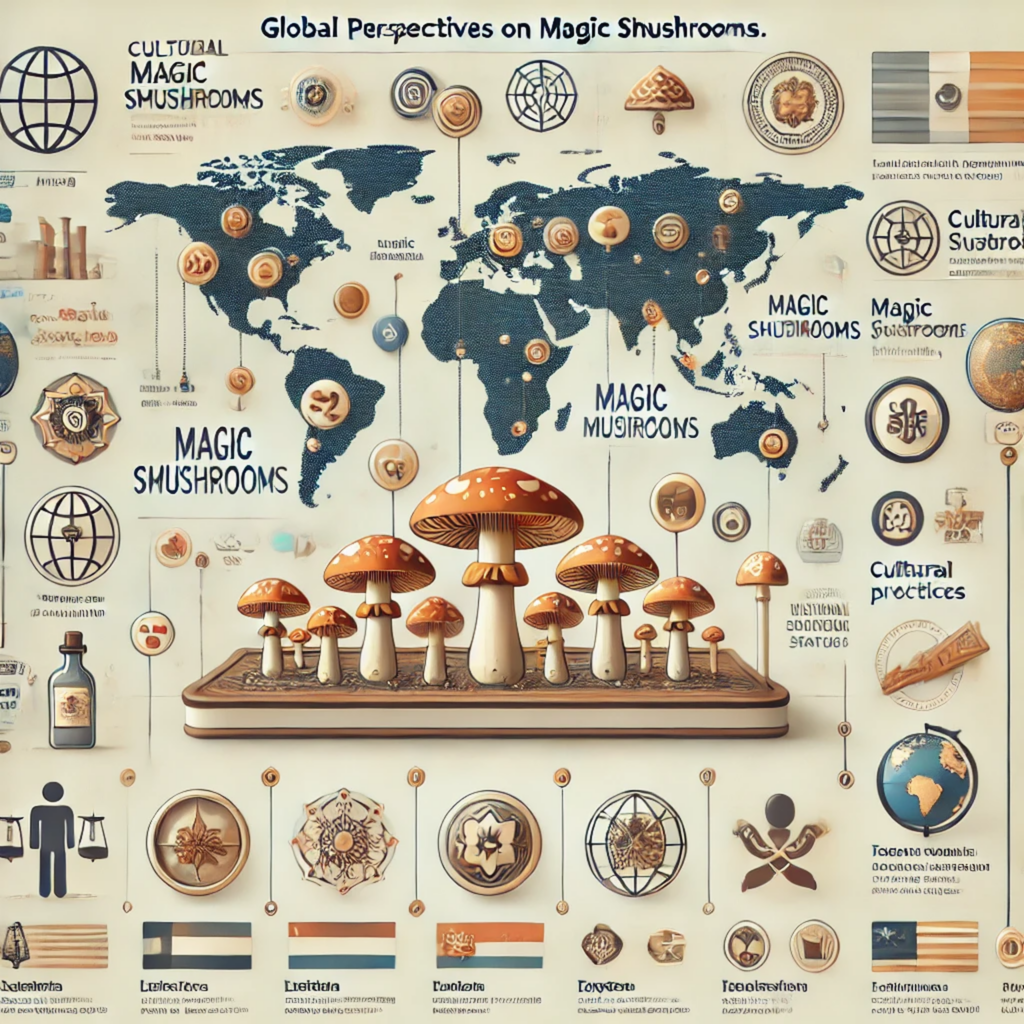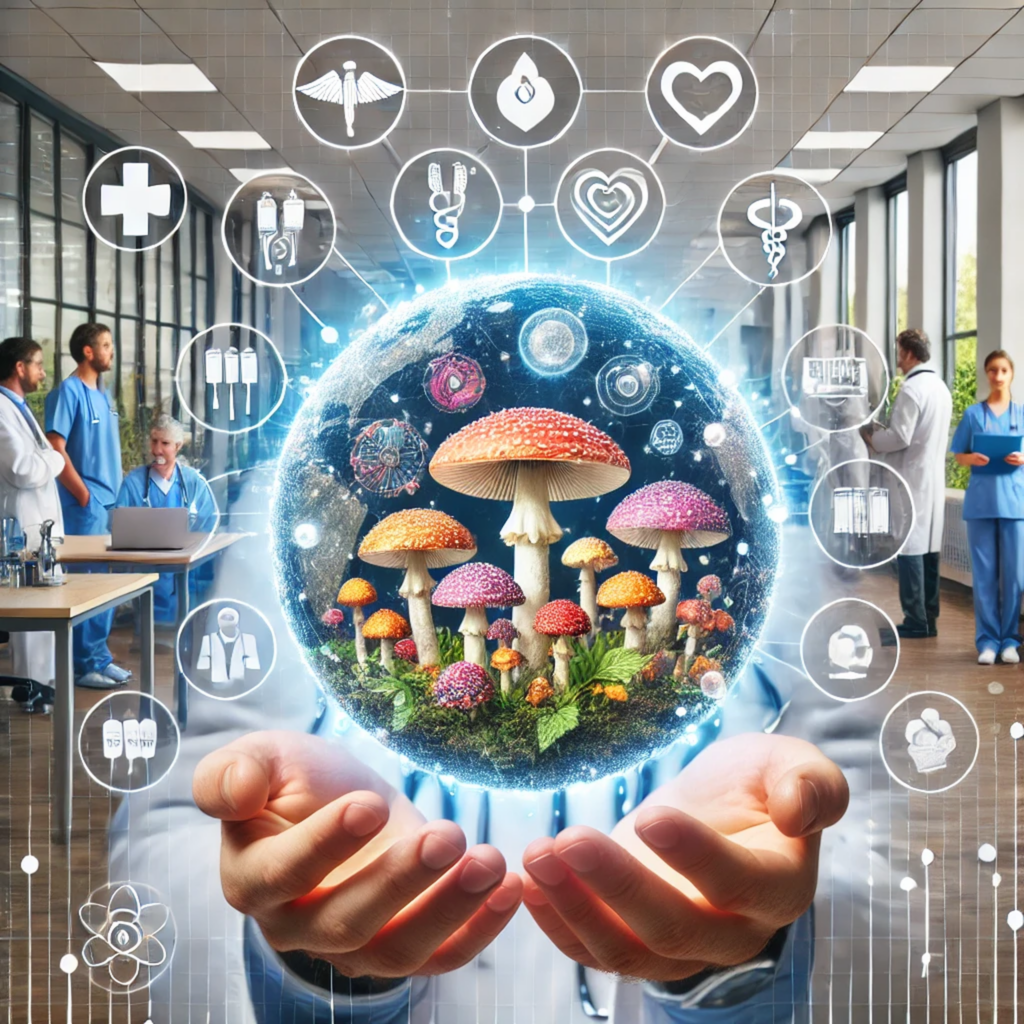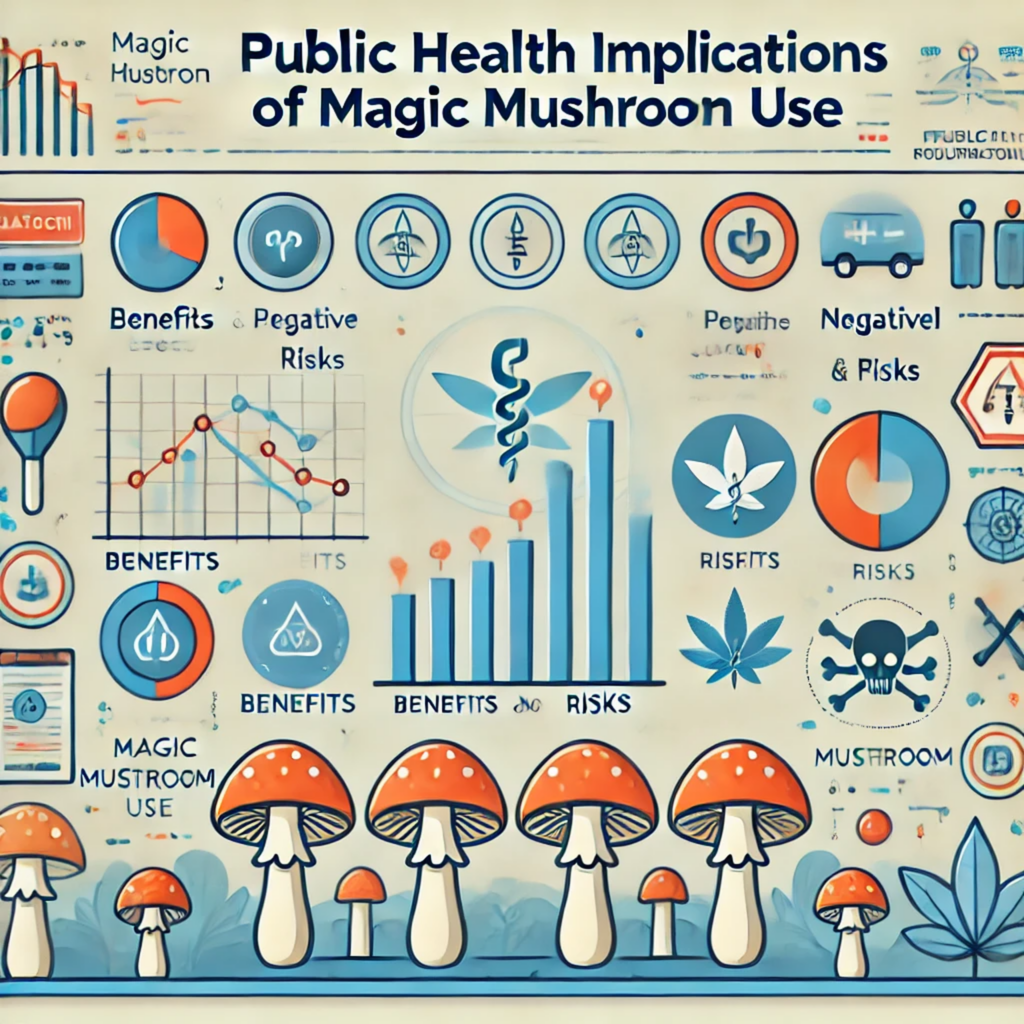Your Ultimate Guide to Psilocybin in 2024
Published: December 18, 2023
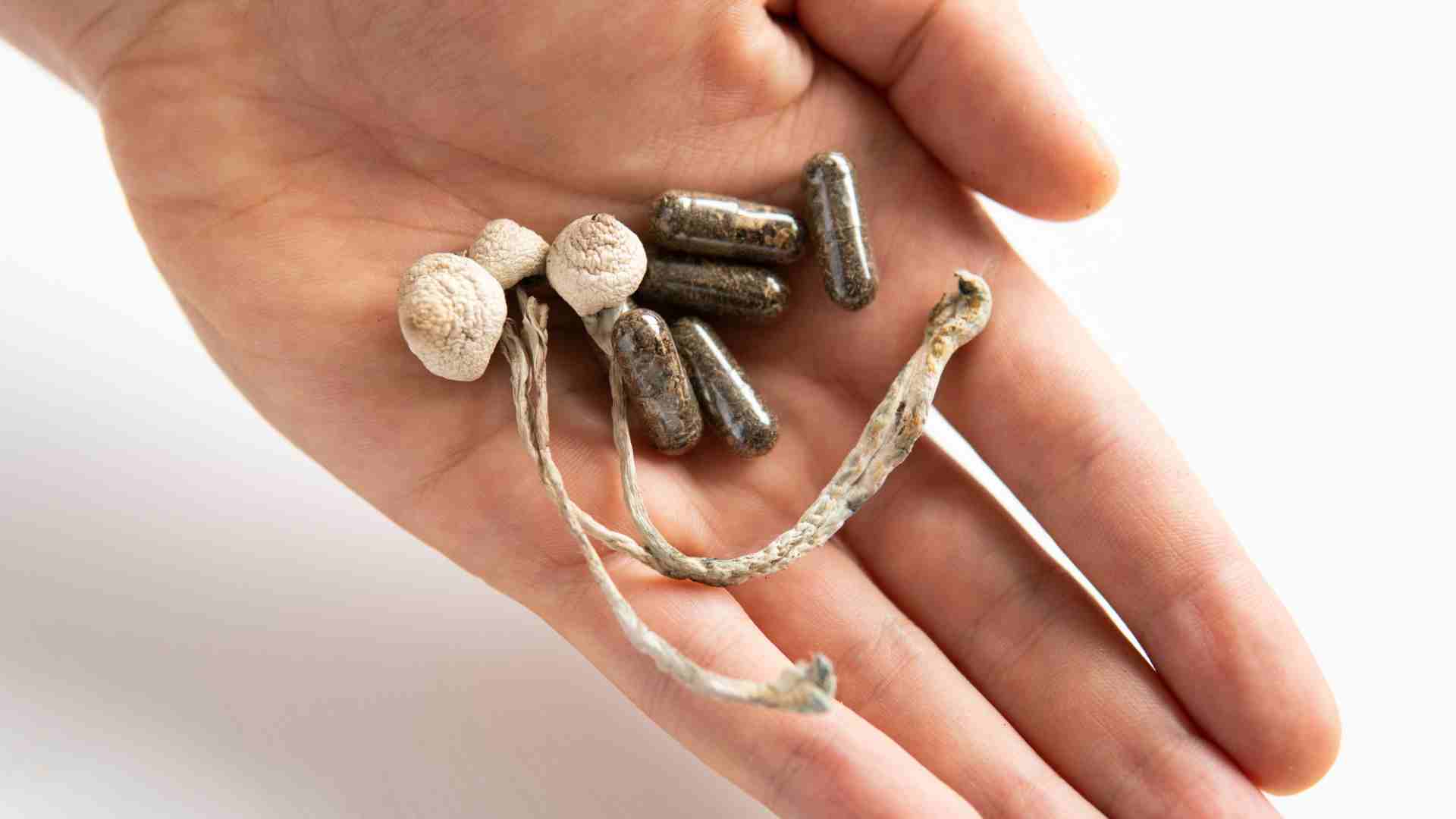
Have you ever wondered about the mysteries and stories surrounding psilocybin, commonly known as the psychedelic compound in magic mushrooms? This natural substance has sparked curiosity, debate, and research for decades, leading us on a fascinating journey through history, science, and personal discovery.
Psilocybin is a naturally occurring psychedelic compound found in over 200 species of mushrooms. These mushrooms, often referred to as “magic mushrooms,” have been used for thousands of years in various cultures for spiritual, religious, and therapeutic purposes. The intrigue around psilocybin isn’t just a modern phenomenon; it has a rich history that intertwines with human culture and consciousness.
Whether you’re a curious newcomer or a seasoned psychonaut, this guide aims to provide a comprehensive understanding of psilocybin, its effects, and its place in our world.
Understanding Magic Mushrooms
Magic mushrooms, the carriers of psilocybin, are not just a single entity but a fascinating world of their own. These fungi, which have captivated human imagination for centuries, are more than just a psychedelic substance; they are a doorway to understanding a unique intersection of biology, culture, and consciousness.
There are over 200 species of magic mushrooms, each with its unique characteristics. These species belong to various genera, but the most well-known is Psilocybe. These mushrooms are typically small, unassuming, and often found in nature growing on decaying wood, dung, or soil rich in organic matter. Despite their humble appearance, they hold within them a compound that has the power to profoundly alter human perception and experience.
The distribution of magic mushrooms spans across continents, from the forests of North and South America to the grasslands of Europe and Asia. Each region’s indigenous species have adapted to their specific environments, contributing to the diversity in appearance, potency, and effects experienced by users.
The key to the magic of these mushrooms lies in their chemical composition. Psilocybin, the primary psychoactive compound, is accompanied by psilocin and baeocystin, which contribute to the mushrooms’ overall psychedelic effects. The concentration of these compounds can vary significantly between species and even within mushrooms from the same batch. This variability is a crucial factor to consider for those seeking a particular experience or intensity level.
The history of magic mushrooms is as rich and varied as the species themselves. For thousands of years, indigenous cultures across the globe have used these mushrooms in religious rites, healing ceremonies, and spiritual practices. In these contexts, mushrooms were revered as sacred tools that provided healing, insight, and connection to the divine.
In the modern era, magic mushrooms stepped into the limelight during the 1950s and 60s, becoming a symbol of counterculture and spiritual exploration. This period saw a surge in interest and research, but also controversy and legal challenges. Despite the legal hurdles, the cultural impact of magic mushrooms has been profound, influencing art, music, and the broader conversation on consciousness and spirituality.
Today, as we stand at the crossroads of renewed scientific interest and evolving legal landscapes, magic mushrooms are being reevaluated not just as a substance of recreation or spiritual pursuit, but as a potential key to unlocking new ways of treating mental health conditions.
Types of Magic Mushrooms
As we delve deeper into the world of magic mushrooms, it’s essential to understand the diversity within this fascinating group. Each type of magic mushroom carries its own unique profile of effects, appearances, and historical significance. Let’s explore some of the most notable types of magic mushrooms, which have captivated the minds and hearts of people around the globe.
If you want to learn more, read our complete guide on types of mushrooms.
Psilocybe Cubensis
Often referred to as “cubes,” this is perhaps the most well-known and widely available type of magic mushroom. Psilocybe Cubensis mushrooms are known for their moderate to high psilocybin content and are favoured for their robust nature, which makes them relatively easy to cultivate. They are characterized by their large, golden caps and are often associated with a balanced, euphoric psychedelic experience.
Psilocybe Semilanceata
Commonly known as “Liberty Caps,” these mushrooms are famous for their distinctive pointed caps. They are typically found in damp, grassy fields, often frequented by grazing animals across Europe and North America. Despite their small size, Liberty Caps are known for their strong potency and are often associated with intense visual experiences and profound philosophical insights.
Psilocybe Azurescens
This species is renowned for being one of the most potent magic mushrooms in the world. Originating from the West Coast of the USA, Psilocybe Azurescens thrives in cooler temperatures. They are distinguished by their conical caps and a bluish hue, which becomes more pronounced when the mushroom is bruised. Users often report extremely powerful and transformative experiences with this species.
Psilocybe Cyanescens
Also known as “Wavy Caps,” due to the distinctive wavy appearance of their caps, these mushrooms are highly potent and are found in both Europe and North America. They grow in clusters and are often found in mulched gardens or near decaying wood. Psilocybe Cyanescens is known for delivering a strong visual and introspective experience.
Psilocybe Mexicana
These mushrooms hold historical significance, as they were the species first used by the indigenous peoples of Mexico for religious ceremonies. Psilocybe Mexicana is known for its mild to moderate effects, making it a suitable choice for those new to the world of psychedelics. They are characterized by their small, bell-shaped caps.
Amanita Muscaria
While not a psilocybin mushroom, Amanita Muscaria, commonly known as the Fly Agaric, is worth mentioning due to its iconic status in popular culture. It’s easily recognizable by its bright red cap with white spots. However, it’s important to note that Amanita Muscaria contains different psychoactive compounds and produces a very different effect compared to psilocybin mushrooms.
Psilocybin and the Brain
Trying to understand how psilocybin interacts with our brain is like unlocking a mysterious door to our consciousness. This exploration not only illuminates the effects of psilocybin on our minds but also offers insights into the intricate workings of our brain.
Psilocybin, the primary psychoactive component in magic mushrooms, is a fascinating molecule that, upon ingestion, is converted into psilocin. It’s this compound, psilocin, that primarily interacts with our brain, leading to the profound experiences associated with psychedelic mushrooms.
The Serotonin Connection
The key to understanding psilocybin’s effects lies in its similarity to serotonin, a neurotransmitter crucial for regulating mood, cognition, and perception. Psilocybin’s chemical structure closely resembles that of serotonin, allowing it to bind to and activate serotonin receptors in the brain, particularly the 5-HT2A receptor. This receptor plays a significant role in cognitive processes, including imagination, creativity, and the formation of meaning and significance.
Altered Brain Connectivity
When psilocybin binds to these receptors, it leads to an altered state of consciousness. One of the most intriguing effects is the disruption of the Default Mode Network (DMN), a network of brain regions that are active when our mind is at rest and not focused on the outside world. The DMN is associated with self-referential thoughts and mind-wandering. Psilocybin decreases the activity in the DMN, which correlates with the dissolution of ego and a sense of oneness with the universe that many users report.
Enhanced Emotional and Sensory Processing
Psilocybin also affects other brain regions involved in emotional and sensory processing. Users often report heightened sensory experiences, vivid imaginations, and emotional breakthroughs. This is likely due to the increased connectivity between different parts of the brain that don’t usually communicate directly. Colours might seem brighter, sounds more profound, and emotions more intense.
Therapeutic Potential
The impact of psilocybin on the brain is not just about the psychedelic experience. Its ability to disrupt entrenched neural patterns and promote neural plasticity has significant implications for mental health. Research suggests that psilocybin therapy can be effective in treating conditions like depression, anxiety, and PTSD, where there are often rigid patterns of negative thinking.
Long-term Changes
Interestingly, the effects of psilocybin can extend beyond the immediate experience. Many users report long-lasting changes in their outlook on life, feeling more connected to others, and having a more positive mood. This could be due to the ‘reset’ effect psilocybin has on the brain’s neural circuits, allowing individuals to break free from the cyclical patterns of negative thought and behaviour.
Understanding how psilocybin works in the brain is not just about comprehending a psychedelic experience; it’s about gaining insights into the very nature of our consciousness and mental health. This knowledge paves the way for new therapeutic approaches and a deeper understanding of the human mind.
Impact on Creative Thinking and Artistic Expression
Psilocybin, the psychedelic compound found in magic mushrooms, has long been associated with enhanced creativity and artistic expression. This connection isn’t just anecdotal; it’s grounded in the profound changes in perception and thought processes that psilocybin induces. Artists, musicians, and writers often report that psilocybin experiences have inspired them, unlocking new perspectives and ideas that they hadn’t accessed before.
Studies and Anecdotal Evidence
Both scientific studies and personal accounts support the idea that psilocybin can enhance creativity. Research suggests that psilocybin disrupts conventional thought patterns, allowing the mind to explore ideas and connections that it might not otherwise consider. This disruption can lead to novel insights and perspectives, which are crucial components of the creative process.
Potential Mechanisms Behind Creativity Enhancement
The enhancement of creativity under the influence of psilocybin may be attributed to several factors. One key aspect is the substance’s ability to reduce the activity of the Default Mode Network (DMN) in the brain, which is associated with self-referential thoughts and mind-wandering. This reduction can lead to a state of “hyper-connection” between different brain regions, fostering unique associations and ideas. Additionally, the emotional depth and perceptual changes experienced during a psilocybin trip can also contribute to creative inspiration.
Psilocybin and Self-Exploration
Psilocybin’s capacity to induce profound introspective states makes it a powerful tool for self-exploration and self-awareness. Users often report gaining deep insights into their thoughts, emotions, and behaviors during psilocybin experiences. This introspection can lead to a better understanding of oneself and one’s place in the world.
Personal Growth and Transformative Experiences
Many people find that psilocybin experiences are not just about the immediate effects but also about the long-term personal growth and transformation that can result. These experiences can be pivotal moments in an individual’s life, leading to significant changes in perspective, values, and priorities.
Integration into Personal Development
The integration of psilocybin experiences into personal development is a critical aspect of its role in self-exploration. This process involves reflecting on the insights gained during the experience and finding ways to apply them in everyday life. Proper integration can lead to lasting positive changes in one’s life, including improved mental health, increased empathy, and a greater sense of purpose.
Other Effects of Psilocybin
Psilocybin’s effects extend beyond creativity and self-exploration. Cognitively, it can lead to enhanced problem-solving abilities and a more open and flexible mindset. Emotionally, it can provide a sense of connectedness, empathy, and emotional release. Spiritually, psilocybin experiences are often described as deeply meaningful, sometimes even mystical, providing users with a sense of unity and transcendence.
Long-term Changes in Personality and Outlook
Research indicates that psilocybin can lead to long-term changes in personality traits, particularly in terms of increased openness and reduced neuroticism. These changes can result in a more positive outlook on life, greater appreciation for existence, and an increased sense of peace and contentment.
Social and Relational Impacts
Psilocybin can also affect social and relational dynamics. Users often report feeling more connected to others and more empathetic after their experiences. This can lead to improved relationships and a greater sense of community and belonging.
Therapeutic Benefits of Psilocybin
As we turn our attention to the therapeutic benefits of psilocybin, we’re entering a realm where ancient wisdom meets modern science. The potential of psilocybin in mental health treatment is not just a rediscovery of traditional knowledge but also a breakthrough in contemporary medicine.
Depression and Anxiety: One of the most promising areas of psilocybin research is its use in treating depression and anxiety, particularly in cases resistant to traditional treatments. Clinical studies have shown remarkable results, with psilocybin therapy leading to significant and lasting reductions in symptoms. The profound experiences induced by psilocybin, often described as mystical or deeply meaningful, appear to provide patients with new perspectives and insights, helping to break the cycle of negative thought patterns associated with these conditions.
End-of-Life Distress: For individuals facing terminal illnesses, psilocybin has shown potential in alleviating end-of-life anxiety and existential distress. The ability of psilocybin to induce transformative experiences can help these individuals find peace, acceptance, and a renewed sense of connection with the world, significantly improving their quality of life.
Substance Abuse Disorders: Preliminary research suggests that psilocybin may be effective in treating various forms of addiction, including alcohol and tobacco dependence. By facilitating profound personal insights and emotional breakthroughs, psilocybin therapy can help individuals address the underlying issues contributing to their addictive behaviors, offering a path towards recovery that is distinct from traditional methods.
Neuroplasticity and Cognitive Flexibility: Psilocybin’s ability to promote neuroplasticity – the brain’s ability to reorganize and form new neural connections – is at the heart of its therapeutic potential. This increased plasticity can lead to improved cognitive flexibility, allowing individuals to break free from rigid thought patterns and behaviors, a common trait in many mental health disorders.
Long-term Benefits: Unlike many traditional treatments for mental health disorders, psilocybin therapy has the potential for long-lasting effects after just a single or a few sessions. Many individuals report sustained improvements in mood, attitude, and behavior long after the psilocybin experience has ended.
Safety and Tolerability: In controlled settings, psilocybin has been shown to be safe and well-tolerated, with a low risk of addiction and minimal side effects. This safety profile makes it a promising candidate for therapeutic use, especially compared to some traditional psychiatric medications with more significant side effects and dependency issues.
The therapeutic potential of psilocybin is a beacon of hope in the field of mental health, offering new avenues for treatment where conventional approaches may fall short. As research continues to unfold, psilocybin stands poised to revolutionize our approach to mental wellness and healing.
Dosage and Consumption of Psilocybin
Understanding psilocybin dosage and consumption is crucial for a safe and beneficial experience. Whether you’re exploring psilocybin for therapeutic purposes or personal exploration, understanding how to consume psilocybin responsibly is key. Let’s break down the various aspects of psilocybin dosage and consumption.
Methods of Consumption
Psilocybin can be consumed in several ways, each offering a different experience. The most direct method is eating dried magic mushrooms. However, their earthy, sometimes bitter taste isn’t for everyone. An alternative is brewing them into a tea, which can be gentler on the stomach and allows for easier dosage control. For those seeking precision and discretion, psilocybin capsules are available, providing a measured dose in a convenient form. Lastly, for those who enjoy culinary creativity, incorporating psilocybin into edibles like chocolates or gummies is an increasingly popular option.
Factors Influencing Effects
The effects of psilocybin are not solely determined by the dose. ‘Set and setting’ – your mindset and the environment in which you consume psilocybin – play significant roles. A comfortable, safe setting and a positive, relaxed mindset can greatly influence the quality of the experience. Additionally, individual factors like body weight, metabolism, and tolerance can affect how one responds to a given dose.
Starting Safely
For those new to psilocybin, starting with a low dose is advisable. This cautious approach allows you to gauge your sensitivity to the substance and minimize the risk of an overwhelming experience. It’s also recommended to have a sober ‘trip sitter’ or guide, especially for higher doses, to ensure safety and provide support.
Respecting the Substance
Psilocybin is a powerful compound that deserves respect. It’s important to approach its use with intention and mindfulness. This means being informed about the substance, being in a suitable mental and physical state, and being in a safe and supportive environment.
Understanding and respecting these aspects of psilocybin dosage and consumption can lead to a more positive and insightful experience. Whether used for personal growth, spiritual exploration, or therapeutic purposes, psilocybin offers a unique journey into the mind and consciousness.
Psilocybin Mushrooms: Effects and Dosage Guide
Navigating the world of psilocybin mushrooms involves understanding the crucial role of dosage. The amount of psilocybin you consume should be carefully considered based on your body weight and the specific experience or medical benefit you’re seeking. Let’s dive into the various dosage recommendations for dried Psilocybe Cubensis, a commonly used species of magic mushrooms.
Dosage Recommendations:
Microdose: 0.1g – 0.3 grams
Low Dose: 0.25g – 1 grams
Moderate Dose: 1g – 3.5 grams
High Dose (Heroic Dose): 3.5g – 5g and above
Different species of magic mushrooms and truffles may require different dosages. Tools like magic mushroom dose calculator can be incredibly helpful in determining the right dose for you, whether you’re using mushrooms or truffles.
Harm Reduction Advice:
If you’re feeling anxious, depressed, or are in a negative environment, it’s best to postpone your psilocybin experience. The likelihood of having a challenging experience increases under these conditions. Additionally, combining psilocybin with alcohol or other substances, including prescription drugs, is not recommended. Both alcohol and hallucinogens produce psychoactive effects, and their combination can lead to unpredictable and potentially unpleasant side effects.
Microdosing Psilocybin:
Microdosing involves taking very low dosages of psychedelic substances, a practice that gained popularity in Silicon Valley for its purported benefits in enhancing creativity and mood. The dose is so low that it doesn’t produce noticeable psychedelic effects, such as changes in perception. However, users often report subtle shifts in thinking, concentration, creativity, relief from depression, reduced anxiety, emotional openness, alleviation of menstrual pain, heightened spiritual awareness, and increased energy. Microdosing is about gaining the benefits without the intensity of a full psychedelic experience, allowing you to maintain your daily activities like working and socializing.
Low Dose Experience:
A low dose of psilocybin mushrooms can induce mild psychedelic effects. You might notice slight changes in visual perception, a mild body high, and a sense of euphoria. This dosage is often used to enhance creativity, productivity, and brain health, or to add a unique dimension to various situations.
Moderate Dose Experience:
With a moderate dose, the psychedelic effects become more pronounced. You may experience euphoria, introspection, laughter, gratitude, visual patterns, color enhancement, and an increased appreciation for music. However, as you’ll be noticeably tripping, it’s important to choose your environment carefully. Busy, crowded places like cities or clubs might be overwhelming.
High Dose (Heroic Dose) Experience:
At higher doses, experiences like ego dissolution or out-of-body experiences become more likely. High doses of psilocybin can induce a range of experiences from transcendent and enlightening to challenging. It’s important to surrender to the experience, take deep breaths, and approach it with love and openness. Authors like Michelle Janikian, in her book “Your Psilocybin Mushroom Companion,” discuss how these experiences can offer new perspectives on life.
When preparing for a high-dose experience, consider your mindset and setting carefully. Being hyper-aware of your surroundings is common, and the company you keep can significantly impact your experience. For those new to psychedelics, learning basic skills for navigating and processing the experience is crucial. Having a trip sitter can be extremely beneficial, especially for first-timers, as they can provide support and guidance if challenging feelings arise.
Setting clear intentions for your trip can lead to profound insights and understanding. Remember, each psilocybin journey is unique and should be approached with respect and mindfulness.
The Psilocybin Experience
Embarking on a psilocybin journey is like setting sail into the vast, uncharted waters of your own mind. Each experience can be unique, filled with personal insights, emotional revelations, and sometimes challenging moments. Understanding what to expect can help you navigate this journey with greater confidence and openness.
Onset of Effects: After consuming psilocybin, the initial effects typically begin to manifest within 20 to 40 minutes. You might first notice subtle changes in your sensory perception – colors may seem brighter, sounds more distinct, and textures more pronounced. As the effects intensify, these sensory alterations become more pronounced, often accompanied by a sense of euphoria or emotional amplification.
The Peak Experience: The peak of a psilocybin experience is often where the most intense psychological and perceptual changes occur. This phase usually happens around two to three hours after ingestion. During the peak, you might experience profound shifts in thought patterns, time perception, and emotional depth. It’s not uncommon to have intense introspective insights, feelings of interconnectedness, or even mystical-type experiences.
Visual and Auditory Hallucinations: One of the hallmark features of a moderate to high dose of psilocybin is the occurrence of visual and auditory hallucinations. These can range from geometric patterns and vivid colors to more complex visions. Sounds may take on a different quality, and music can feel especially profound.
Emotional Intensity and Release: Psilocybin has a unique ability to bring emotions to the surface. This can be therapeutic, as it allows for the processing and release of emotions that may be difficult to access in everyday life. It’s important to let these emotions flow naturally, as resisting them can lead to discomfort or a challenging experience.
The Comedown: As the effects of psilocybin begin to wane, usually 4 to 6 hours after ingestion, you’ll gradually return to your normal state of consciousness. This comedown phase can be a time of reflection and integration, where you process the insights and emotions experienced during the peak. Many people report feeling a sense of tranquility, clarity, and connectedness during this phase.
Aftereffects: In the days following a psilocybin experience, you may continue to feel changes in your mood and outlook. Many report a lingering sense of openness, increased emotional sensitivity, and a greater appreciation for life. This period is crucial for integrating the experience into your daily life, making sense of any insights gained, and applying them in a meaningful way.
Remember, a psilocybin experience can be unpredictable, and it’s important to approach it with respect, preparation, and a supportive environment. Having a clear intention and a trusted guide or sitter can greatly enhance the safety and meaningfulness of your journey.
Risks and Side Effects of Psilocybin
While psilocybin offers profound experiences and potential therapeutic benefits, it’s important to approach its use with an awareness of the risks and side effects. Being informed helps ensure a safer and more positive experience.
Physical Side Effects: Psilocybin is generally considered safe in terms of physical health, especially when compared to many other substances. However, it can cause some physical side effects, particularly at higher doses. These may include nausea, dizziness, increased heart rate, and changes in blood pressure. These effects are typically temporary and often subside as the experience progresses.
Psychological Challenges: The psychological effects of psilocybin can be intense and sometimes overwhelming, especially for those unprepared or in an unsupportive environment. Users may experience anxiety, confusion, and paranoia, particularly if they consume high doses or are in a negative state of mind (set) or in a stressful setting. It’s crucial to have a supportive, calm environment and, if possible, a trusted guide or sitter to help navigate these moments.
The Risk of a ‘Bad Trip’: A ‘bad trip’ refers to a challenging psychedelic experience, often characterized by fear, distress, or negative hallucinations. While not necessarily harmful, these experiences can be psychologically unsettling. Proper preparation, including mindset and setting, can significantly reduce the risk of a bad trip. It’s also important to remember that challenging experiences can sometimes be insightful, especially with proper support and integration.
Mental Health Considerations: Individuals with a personal or family history of psychosis or other severe psychiatric disorders should approach psilocybin with caution. In some cases, psilocybin can exacerbate these conditions. Consulting with a mental health professional before using psilocybin is advisable for those with underlying mental health issues.
Long-term Effects: Research on the long-term effects of psilocybin is ongoing. While it appears to have a low potential for addiction and does not typically cause long-term harm, the psychological impact of its use can be profound and lasting. This underscores the importance of integration – the process of making sense of and incorporating the psychedelic experience into one’s life.
Legal Risks: It’s important to be aware of the legal status of psilocybin in your region, as it remains illegal in many parts of the world. The legal risks associated with psilocybin possession and use can have significant consequences.
Approaching psilocybin with respect, proper preparation, and an understanding of these risks is key to a safe and beneficial experience. It’s about finding a balance – embracing the potential for growth and healing while being mindful of the challenges and responsibilities that come with its use.
Practical Tips and Safety for Psilocybin Use
Embarking on a psilocybin journey can be a profound and transformative experience. To ensure this journey is as safe and beneficial as possible, it’s essential to consider some practical tips and safety guidelines. Let’s explore how you can prepare for and navigate your psilocybin experience with care and respect.
Set and Setting: The concept of ‘set and setting’ is paramount in the psychedelic community. ‘Set’ refers to your mindset going into the experience – it’s important to feel mentally prepared, open, and as relaxed as possible. ‘Setting’ is about the physical and social environment. Choose a place where you feel safe and comfortable, ideally with minimal distractions and the presence of a trusted person who can provide support if needed.
Start with a Low Dose: If you’re new to psilocybin, it’s wise to start with a low dose to gauge your sensitivity and response. This cautious approach can help you avoid overwhelming experiences and allows you to gradually explore higher doses if desired.
Have a Sober Sitter: Especially for higher doses, having a sober, experienced sitter can be invaluable. This person can provide emotional support, help you navigate challenging moments, and ensure your physical safety.
Stay Hydrated and Avoid Mixing Substances: Keep water at hand to stay hydrated. It’s also advisable to avoid mixing psilocybin with other substances, especially alcohol and other psychoactive drugs, as this can unpredictably alter the effects and increase risks.
Prepare for the Aftereffects: After the experience, you might feel a range of emotions and thoughts. It’s important to give yourself time to rest and process these feelings. Some people find it helpful to journal their experiences or discuss them with a trusted friend or therapist.
Integration is Key: Integration involves processing and making sense of your psychedelic experience. It’s a crucial step in translating any insights or emotional breakthroughs into positive changes in your life. This can involve self-reflection, discussions with others, creative expression, or professional therapy.
Respect the Legal Status: Be aware of the legal status of psilocybin in your area. Despite its potential benefits, psilocybin remains illegal in many places, and legal repercussions can be severe.
Listen to Your Body and Mind: Finally, listen to yourself. If you’re not feeling mentally or physically up to the experience, it might be best to wait. The psilocybin journey should be approached with respect and not taken lightly.
By following these guidelines, you can help ensure your psilocybin experience is as safe, controlled, and meaningful as possible. Remember, the journey into the mind is a powerful one, and approaching it with the right preparation can make all the difference.
Conclusion: Embracing the Journey with 6Mushrooms
As we conclude our comprehensive exploration of psilocybin, it’s clear that this remarkable compound offers a unique and powerful journey into the mind and consciousness. Whether for therapeutic purposes, personal growth, or spiritual exploration, psilocybin presents an opportunity for profound transformation and healing. But where does one begin this journey with confidence and safety? This is where 6Mushrooms steps in.
6Mushrooms stands as a beacon for those seeking to explore the world of psilocybin. Based in Toronto, they offer a wide variety of organic, lab-tested medical mushrooms, ensuring quality and safety for their customers. Their range includes popular selections like Golden Teacher, Penis Envy, Blue Meanies, and Aztec varieties, each offering unique properties and benefits.
Embrace the journey with 6Mushrooms – where quality, safety, and education come together to offer you an unparalleled psilocybin experience.
